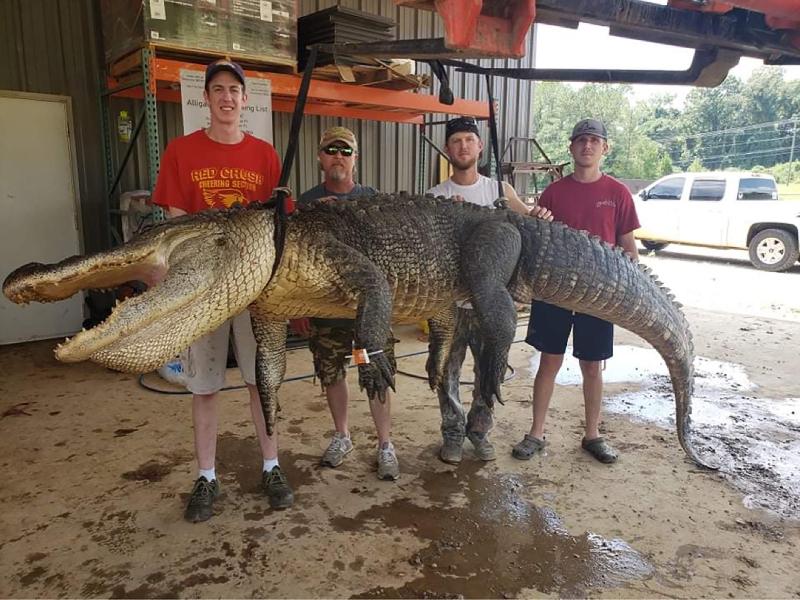How did artifacts, thousands of years old, turn up in a Mississippi alligator's stomach?
By: Brian Broom, Mississippi Clarion Ledger (MSN)



JACKSON, Miss. - What does a 750-pound alligator eat? Well, just about anything it wants, but items found in this particular Mississippi alligator's stomach defy odds and date back thousands of years.
Officers in Mississippi wrestle with massive alligator  The Clarion-Ledger (Jackson) See more videos SHARESHARETWEETSHAREEMAIL What to watch next
The Clarion-Ledger (Jackson) See more videos SHARESHARETWEETSHAREEMAIL What to watch next
Shane Smith, owner of Red Antler Processing in Yazoo City, Mississippi, said he was examining contents of a 13-foot, 5-inch alligator that weighed 750 pounds and discovered two unusual objects. One he couldn't identify, but the other was clearly a broken stone arrowhead.
 © Special to Clarion Ledger (From left) Jordan Hackl of Warrensburg, Illinois, John Hamilton of Raleigh, Todd Hollingsworth and Landon Hollingsworth, both of Mize, pose with an alligator they caught In Mississippi September 2, 2021. Artifacts dating as far back as an estimated 6000 BC were found in the alligator's stomach.
© Special to Clarion Ledger (From left) Jordan Hackl of Warrensburg, Illinois, John Hamilton of Raleigh, Todd Hollingsworth and Landon Hollingsworth, both of Mize, pose with an alligator they caught In Mississippi September 2, 2021. Artifacts dating as far back as an estimated 6000 BC were found in the alligator's stomach.
The find was so unexpected, he almost didn't let the news out.
"At first, I thought 'I'm not posting this on Facebook,' because no one will believe it," Smith said.
Then, he had second thoughts.
"This is too cool not to post of Facebook," he said. "This has probably never happened before. We gotta post this."
Alligators in Mississippi: 5 things you may not know about the South's apex predator
Dog tags in an alligator's stomach
The story first began to unfold in April when a wild game processor in South Carolina reported opening the stomach of an alligator and finding unusual items. Smith read it and was skeptical.
"The curiosity struck me when I saw a post online about someone finding dog tags in an alligator's stomach," Smith said.
To satisfy that curiosity, Smith decided to examine contents of the larger alligators he processed. The first was a 13-foot, 2-inch, 787-pound gator taken by Ty Powell of Columbia, Mississippi.
"We found a bullet in it, and it had not been fired from a gun," Smith said. "I don't know how it got in there."
The second alligator he opened, which was harvested at Eagle Lake, located 15 miles northwest of Vicksburg on the Mississippi and Louisiana border, contained many of the things the first did, including bones, hair, feathers and stones. Then, something else caught his eye.
 © Shane Smith/Special to Clarion Ledger A prehistoric projectile point and another prehistoric object known as a plummet were discovered in the stomach of a 13-foot, 5-inch Mississippi alligator.
© Shane Smith/Special to Clarion Ledger A prehistoric projectile point and another prehistoric object known as a plummet were discovered in the stomach of a 13-foot, 5-inch Mississippi alligator.
A find like no other
"Everybody was standing around like I was opening a Christmas present," Smith said. "We kind of put it all in a bin.
"I looked over and saw a rock with a different tint to it. It was the arrowhead."
Smith said he was dumbfounded.
"It was just disbelief," Smith said. "There's just no way he had an arrowhead. Your first thought is it ate (a Native American) or (a Native American) shot it in the stomach."
Smith knew that wasn't the case, though.
"My best hypothesis is wherever he scooped up those other rocks, he got that (Native American) point," Smith said. "We joked about it and said I'm probably the only person on Earth to pull an arrowhead out of an alligator's stomach."
Point dates back thousands of years
James Starnes, director of Surface Geology and Surface Mapping for the Mississippi Department of Environmental Quality, examined a photograph of the point. He estimated it was made about 5000-6000 BC.
'That is the latter part of the Early Archaic and early part of the Middle Archaic (periods)," Starnes said. "How the base is made is real tell-tale in estimating the time period."
Starnes also noted the object is not an arrowhead. It's a point used on an early weapon that launches a spear using a second piece of wood with a cup on one end which acts as a lever to increase velocity.
"That's an atlatl dart point," Starnes said. "People think all heads are arrowheads, but those (arrowheads) would be the little bitty points."
As bizarre as the find was, it was about to get even stranger. Smith found a heavy, tear-shaped object roughly 1½ inches in length. Both he and the hunter who was permitted to harvested the alligator thought it was something more modern — a lead weight used for fishing.
"It's heavy like lead," Hamilton said. "It looks like it's got two holes in it, but they don't go through it.
"It's got a little hole and a bigger hole on top. I guess it goes in and comes back out."
What's a plummet, and why would an alligator eat it?

Starnes said it's known as a plummet and dates back to the Late Archaic Period, or about 1700 BC.
The weight is accounted for because it's made of hematite, an iron oxide traded between early groups and shines when polished. Starnes said what purpose plummets served is unknown.
"The plummets, we really have no idea what they were used for," Starnes said. "These things had some significance, but we have no idea. We can only guess."
So, how did these ancient objects get into the alligator's belly? Ricky Flynt, Mississippi Department of Wildlife, Fisheries, and Parks Alligator Program coordinator, explained very hard objects, typically stones, aid the reptiles in digestion.
"Alligators, like other animals such as birds and other reptiles, are known for ingesting grit and rocks to help with digestion," Flynt said. "We know alligators and crocodiles do that."
However, alligators differ from fowl such as chickens and ducks. Those animals have gizzards and the grit and sand is stored there to help grind seeds and grains they consume. Alligators don't have gizzards and the stones go into the stomach.
"Sticks, wood; things they can't digest get into their stomachs," Flynt said. "I found a piece of cypress in an alligator's stomach that was 15 inches long."
Follow Clarion LedgerOutdoors on Facebook and @BrianBroom on Twitter.
This article originally appeared on Mississippi Clarion Ledger: How did artifacts, thousands of years old, turn up in a Mississippi alligator's stomach?

 Article is LOCKED by moderator [Split Personality]
Article is LOCKED by moderator [Split Personality]
Tags
Who is online
42 visitors


That was a bigun. I have seen them in rivers before but never that size.
The biggest I have seen in the wild was in the Atlantic about 30 yards off the beach on Fripp Island.
The kids thought it was a log...
I think the largest I ever saw in captivity was a place in Naples on Tammiani Trail now called Wootens.
Gator farm and airboat tours...
Probably 30 years ago, the name was catchier though, lol.
Jungle Larry's Caribbean Garden ! 43 acres, now the Naples Zoo!
Great place. Cheap and family friendly at the time.
My dad was visiting my uncle in Florida, and my uncle took him fishing. Dad dropped something (his hat, maybe?) and went in after it. My uncle told him to get his ass back in the boat. Dad asked why, and my uncle pointed out the "logs" that weren't logs. Dad got his ass back in the boat.
Saw some small gators in Florida when I was in the Navy, about 5 feet or so. Those did not even compare to Salt Water Crocs I saw in Southeast Asia many years later. Those were big puppies at 10 to 15 feet or so.
I told them logs don't change direction or splash, lol.
More than likely these objects came from the builder of the Poverty Point Mounds. They are in the same area as this gator was harvested in. The mounds and the people date back 3400 years. Fishing was one of their mainstays for food so finding their artifacts in the water/swamp is not unusual.
I just posted an article on the mounds and their builders earlier this morning.
We have some good-sized gators in Florida. This is Chubbs, around 15 ft long and a guesstimate of the weight of over 800 lbs. He lives around the golf courses in Manatee County (Gulf Coast). If you're playing golf in the county and hit it into a water hazard or close to a pond proceed with caution.
they had a gator in a pond at a local golf course in texas I played at. I would chip damaged balls at it as practice.
not a big fan of reptiles. at my oldest son's house 2 weeks ago he sees the tail of a big snake go into the open garage at dusk, on the disorganized side. because of it's size we really didn't want an overnight guest. we had a difficult time locating him until he made an appearance by the back door and then disappeared between the wall and the junk leaning against it. we cleared an escape route for him and hung back until he decided to leave a few minutes later. my son took a cell phone video of it's departure across the driveway into the bushes so we could identify the species. at first we thought it was an escaped constrictor, but it turned out to be a bull snake. a big one at 6-7 feet long. haven't seen as many bunnies around since.
That is a big bull snake.
it's starting to get a bit nippy here at night and those guys are looking for a warm spot. if my son hadn't seen it go into the garage it would have been a not so nice surprise for somebody later on.
I found a blacksnake skin next to my wood pile a few weeks ago. My dog is terrified of it, so I'm pretty sure he's been bitten at some point.
cats are really good about finding snakes, and usually living past the encounter...